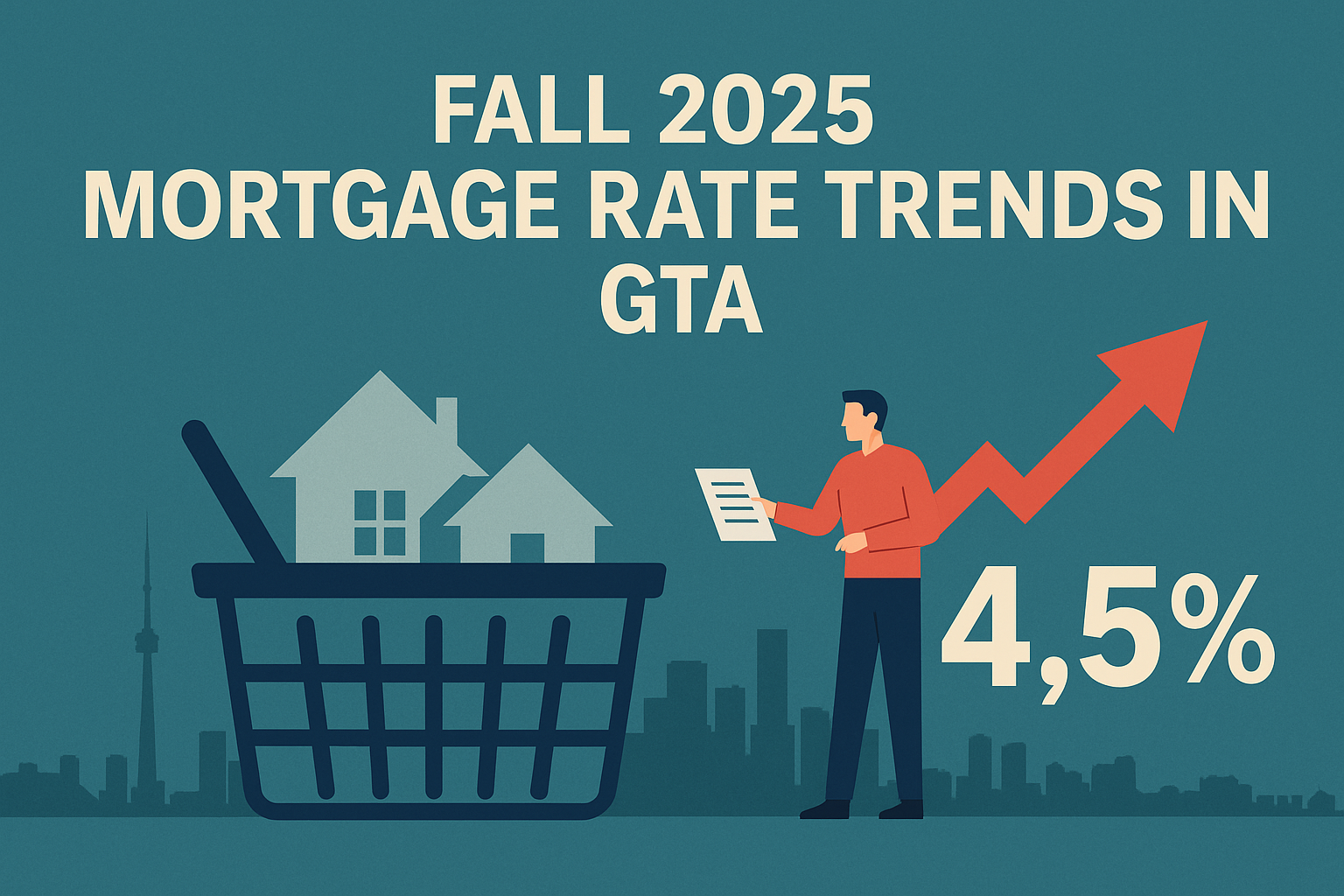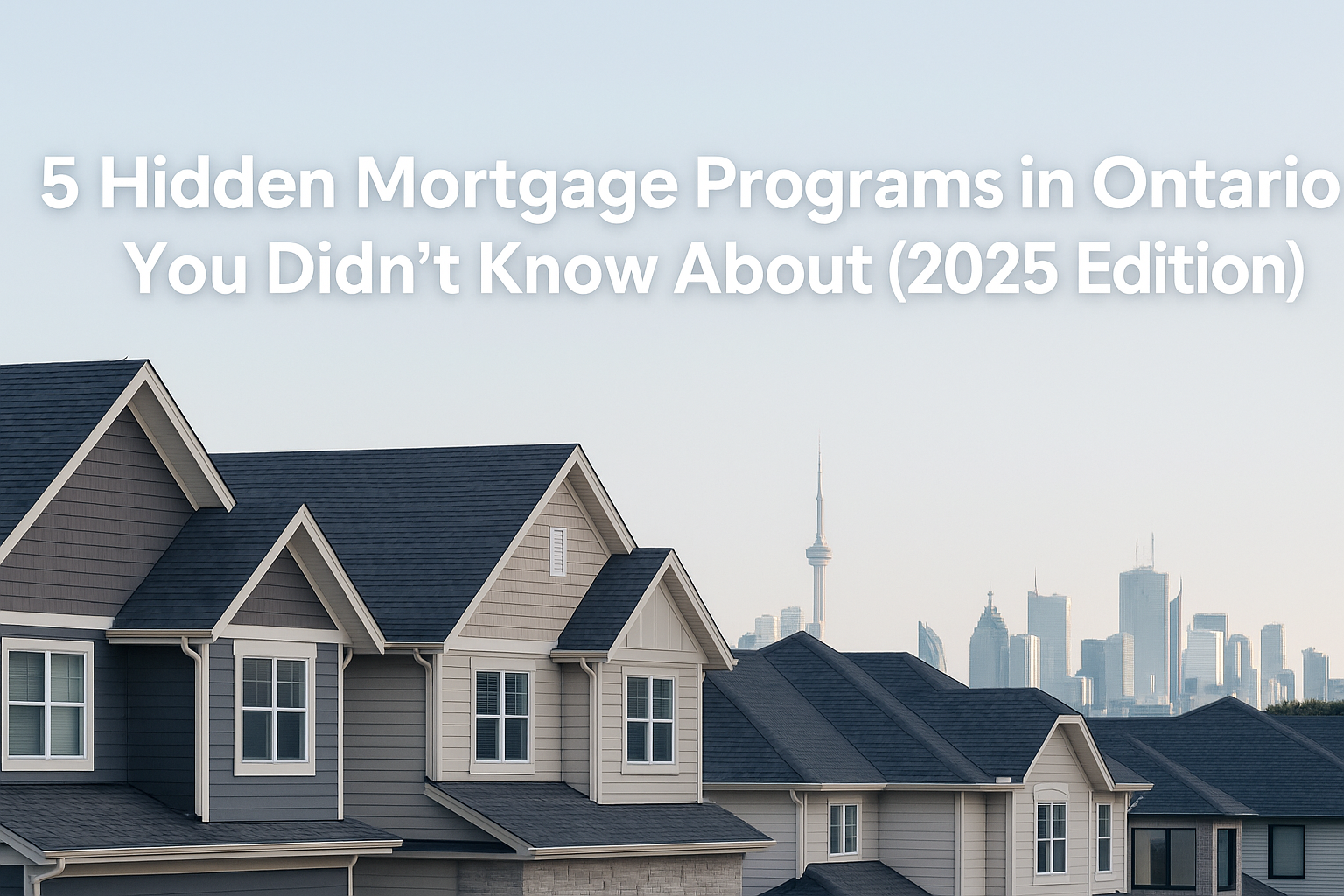Fall 2025 Mortgage Rate Trends in the Greater Toronto Area (GTA) – What You Need to Know

Inflation, interest rates, home-prices and mortgage costs: these four are intimately linked—especially here in the GTA. As we enter Fall 2025, the mortgage-rate environment is in flux, and understanding what’s going on is critical for anyone buying, renewing or refinancing a home right now. Let’s dive into the trends, the drivers, the implications, and what you need to know to act wisely.
1. Current landscape: Where rates stand
To set the stage, here are the big pieces of the puzzle:
- The Bank of Canada’s policy (overnight) rate is now 2.50%, following a 25-basis-point cut on September 17, 2025. Bank of Canada+2Perch+2
- Mortgage rate-forecast models suggest that five-year fixed rates in Canada might edge modestly lower — for example some sources show 5-year fixed rates possibly being in the ~3.60-4.00% range under favourable conditions. WOWA+2Mortgage Sandbox+2
- On the variable-rate side, the prime rate and variable mortgage offers have also shown movement: for example the 5-year variable best-offers around ~3.70% are being noted. Ratehub.ca
- For the GTA market specifically: while broad Canada-wide rates give the backdrop, local housing market conditions matter a lot—affordability, competition for mortgages, supply of listings, price trends. For example, the average home sold price in the GTA in September 2025 was reported at ~$1,059,377, down ~4.3% year-over-year. WOWA
So, in short: mortgage rates remain elevated compared to historical lows, but in the current environment they are showing signs of stabilizing or modest improvement. That said, small shifts make a big difference when you’re talking about a multi-hundred-thousand-dollar mortgage.
2. What’s driving the trends?
Several interconnected forces are shaping mortgage rate trends in the GTA for Fall 2025.
A. Monetary policy & the Bank of Canada
The Bank of Canada’s rate decisions directly affect variable borrowing rates and indirectly influence fixed-rate offers through bond markets. As noted, the BoC cut to 2.50%. Bank of Canada+1
Forecasts suggest further cuts maybe down to ~2.25% by the end of 2025 under some scenarios. TD Economics+1
But: the BoC is also mindful of inflation and housing-market risks. For example, inflation pressures or a reheating housing market could delay or reverse rate cuts.
B. Bond yields & long-term cost of borrowing
Fixed mortgage rates are influenced heavily by long-term yields (10-year Government of Canada bonds) because lenders hedge or price risk based on those. If yields rise (due to inflation fears or global market stress), fixed rates go up; if yields fall, fixed rates can drop. Forecasts suggest fixed rates may fall but will likely remain above the ultra-low levels seen during pandemic years. NerdWallet+1
In the GTA context, because home values and borrowing amounts tend to be higher, a small change in rate leads to materially different monthly payments.
C. Housing market conditions in the GTA
The GTA has been showing signs of moderation: the benchmark home price in September 2025 at ~$960,300, down ~5.5% year-over-year. WOWA
Why this matters: If home-prices are falling or sales activity is weak, lenders may perceive more risk (for e.g., if borrowers default or homes have less equity cushion) and may maintain rates somewhat higher. Conversely, improved affordability could stimulate demand, pushing borrowing costs up if competition heats.
D. Affordability and debt service burden
Mortgage-service costs in the GTA are substantial: when rates were higher earlier this year, many buyers paused or downsized. With current rates still “higher than ideal”, affordability remains a constraint. Some sources highlight that mortgage expense is “the most significant expense” for many Canadian families, especially in high-cost regions like the GTA. WOWA
When borrowers already have large debt loads, lenders are more cautious. That caution can keep mortgage rates from dropping too far — or encourage lenders to add “premium” for risk.
E. Domestic & global economic risks
Trade tensions, supply-chain issues, inflation shocks, labour-market developments: all matter. The BoC in its communications has flagged risk of “weak consumer spending” and uneven growth. Mortgage Rates Canada
For mortgage rates this means uncertainty remains: if the economy weakens, rates may drop; but if inflation or housing-market overheating resurfaces, rates may remain sticky or even climb.
3. Fall 2025 mortgage-rate themes in the GTA
Given the above drivers, here are specific themes to watch for the remainder of 2025 in the GTA:
Theme 1: “Hold or slowly slide” in fixed rates
While we might hope for a dramatic drop in fixed-rate mortgages, the reality is likely to be modest improvement. For example, forecasts show 5-year fixed could decline by ~0.5 % by year-end under favourable conditions. Mortgage Sandbox
In the GTA context, that means if you’re locking in a fixed rate at e.g., 4.3–4.8% now, you might see offers of ~3.9–4.3% toward year-end — but don’t expect <3% any time soon.
For borrowers renewing in late 2025 or early 2026, monitoring the “spread” between your current fixed rate and the new more competitive fixed rates will matter.
Theme 2: Variable-rate (and hybrid) options may gain relative attractiveness
With the prime rate down and the BoC cuts, variable-rate mortgages (or shorter-term fixed + variable hybrids) may offer good value for certain borrowers. For example, some brokers note best 5-year variable offers around ~3.70%. Ratehub.ca
But variable comes with risk: if the BoC reverses course, your payment could rise. In the GTA with large mortgages, the “risk premium” (how much extra you’ll pay if rates go up) might be larger.
Theme 3: Renewals and refinancing will be a major story
Many GTA homeowners who locked in fixed rates 3–4 years ago may be facing renewal in the next 12–18 months. How they handle renewal will be critical:
- Do they lock a longer-term fixed now?
- Do they shift to variable or hybrid?
- Do they pay down more principal (if affordable) to reduce stress?
Refinancers will also weigh whether it’s worth “breaking” a fixed term early (with potential penalty) to capture a lower rate.
Theme 4: Borrower behaviour and risk-management will matter
In the GTA’s higher-cost real-estate market, even small rate changes matter to monthly payment and affordability. Borrowers will need to:
- Stress-test payments assuming rates rise 1-2 % above current levels.
- Consider amortization length: staying closer to 20-25 years rather than stretching to 30 or 35 may reduce risk.
- Check their total debt-service ratio (TDSR) and variable payment ability — lenders will dig deeper in tighter markets.
- Consider fallback plans: e.g., what happens at renewal if fixed rates don’t fall as hoped?
Theme 5: Regional nuance within the GTA
Not all parts of the GTA behave the same. Urban Toronto may differ from outer suburbs in terms of demand, inventory, and property-type mix (condos vs detached).
For example, detached home average in the GTA in September 2025 was ~$1.36M down ~4.5% year-over-year. WOWA
For condo buyers the sensitivity to interest-rates may differ (lower purchase price but higher competition). So when considering mortgage choices, the type of property and location matters.
4. What this means for you (buyers, renewers, refinancers in the GTA)
Let’s translate these themes into practical implications.
A. For first-time or new buyers
- Lower rates would increase your buying power, but don’t count on large drops. If there’s a house you like, waiting for a “rate crash” may cost you in price increases or missed opportunity.
- Compare fixed vs variable: If you lock a fixed now you get certainty; if you go variable you might get a lower rate but face risk. If you choose variable, make sure you’re comfortable if rates rise.
- Factor in full cost of homeownership: in the GTA, property taxes, maintenance, condo fees (where applicable), are significant — lower rate is good, but debt burden still needs to be manageable.
- Consider choosing a shorter amortization (20 or 25 years) if possible to reduce long-term risk, rather than stretching to 30–35 because of slightly lower monthly payments.
B. For renewers
- Start rate shopping early: your renewal date matters. Even a 0.5 % difference in rate can change monthly payment by hundreds of dollars on a large mortgage.
- Evaluate your goals: Do you stay with your current lender for convenience? Or switch for better terms? Consider break-costs if you are early.
- If you’re satisfied with your current rate but feel that rates might drop, you could extend your term (e.g., go from 3-year fixed to 5-year fixed) if comfortable, locking in price-certainty.
- If you have variable rate and are comfortable with risk, monitor the market for potential switch to fixed if you believe rates may rise. Or conversely stay variable if you think they’ll fall.
C. For refinancers or investors
- Refinancing in the GTA may make sense if you can get a lower rate and reduce monthly payments, or pull equity now for other uses (e.g., renovations, investment).
- But beware: fees, penalties, closing costs matter more in high-value markets like the GTA. Ensure net benefit.
- Investors: higher mortgage rates squeeze rental yield margins if your property is financed. Consider longer-term fixed financing to lock cost, especially if you believe rates might rise or stay elevated.
D. For risk-management generally
- Stress test your payment: What if rate goes up by 1.0% or more? What’s your fallback?
- Maintain buffer savings: Since affordability is tight in the GTA, having reserves for unexpected interest or payment rises helps.
- Keep an eye on term expiry: Some shorter-term fixed (e.g., 1- or 2-year) may expire soon—ensure you know your next move.
- Consider amortization reset: If you shortened amortization or increased payment during good times, you’ll reduce risk; if you stretched amortization or picked minimal payments, you may be more exposed.
5. What to watch in the coming months
Here are key indicators and events in Fall 2025 to monitor — they’ll affect the rate environment in the GTA.
- Next policy decisions by the Bank of Canada: watch announcements, accompanying commentary on inflation/housing.
- Bond-yield movements: 10-year Government of Canada yields will signal fixed-rate direction.
- Housing market data in the GTA: price trends, sales volume, listings. For example the recent year-over-year price drop ~5.5% in the GTA benchmark is relevant. WOWA
- Inflation and labour-market data: inflation stickiness may push rates up; softening may favour rate cuts.
- Mortgage rate spreads: gap between best-offers and average rates – a narrower gap may mean more borrowers able to access strong deals.
- Renewal rate behaviour: How much are lenders increasing renewal rates? If renewals spike, it may squeeze household budgets and ripple into housing demand.
- Government/regulatory changes: e.g., stress-test rules, amortization limits, insurance changes – these can impact borrower access and hence demand for mortgages.
6. Strategic scenarios for the GTA borrower
Let’s walk through three hypothetical scenarios a GTA homeowner or buyer might face, with strategic responses.
Scenario A: You’re buying in Autumn 2025
You’ve found a decent property in the outer GTA suburb; you’ll need a mortgage of ~$800,000. Fixed vs variable decision looming.
Strategy:
- Check current best fixed rates (say ~4.3%) and variable best (~3.7%).
- If you value stability and expect rates to rise, lock fixed for 5 years.
- If you believe the rate environment will soften and are comfortable with risk, consider variable (or hybrid fixed for 2–3 years then variable).
- Budget assuming payment might increase (or rate might be higher) – stress test.
- Consider shorter amortization (e.g., 20-25yrs) to reduce payment risk.
Scenario B: You’re up for renewal in early 2026
You locked 5-year fixed in 2021 at ~2.79% and now your term ends March 2026. Rates now are higher (~4.4%).
Strategy:
- Monitor rates now: if they fall over next 6 months, you may be able to secure ~4.0% or less.
- Decide whether to lock earlier (e.g., now for April) or wait to see if rates drop further (risk vs reward).
- Consider switching lenders if your current one isn’t competitive.
- Evaluate paying down extra principal before renewal to reduce mortgage size and risk.
Scenario C: You’re refinancing an existing property in the GTA
You have equity in a townhouse and want to pull $150k for renovation/investment.
Strategy:
- Evaluate total cost: penalty for breaking current mortgage + new mortgage rate + closing cost vs benefit of renovation/investment.
- Consider fixed cash-out mortgage term (5-year fixed) if you want stable payments.
- If comfortable, consider variable or line-of-credit structure but watch risk.
- Ensure rental or renovation project yield more than incremental borrowing cost + extra risk.
7. Common mistakes to avoid
- Waiting too long: If you assume rates will drop significantly and they don’t, you may miss out on favourable conditions.
- Over-leveraging: In the GTA high home-cost market, stretching amortization or taking minimal payments increases risk.
- Ignoring renewal/expiry: Many homeowners forget that fixed-terms expire and the new rate may be much higher – plan early.
- Choosing rate only: Don’t just chase the lowest rate; consider term length, amortization, pre-payment flexibility and total cost.
- Neglecting macro context: Housing market conditions, affordability and economic risk matter just as much as “rate trend”.
8. Summary & take-away
Fall 2025 in the GTA presents a mortgage landscape that may feel “better” than earlier in the year, but it is by no means back to bargain-basement rates. Fixed rates appear to be gradually improving, variable rates may offer relative value, but the risk of rate reversal, affordability pressure, and housing-market nuance remain prominent.
If you’re buying, renewing or refinancing in the GTA you should:
- Start early: monitor rates today, not just when your contract ends.
- Stress-test payment scenarios including rate increase.
- Choose a mortgage type (fixed/variable/hybrid) that matches your risk-comfort and timeline.
- Consider amortization carefully — shorter amortization means less risk.
- Keep an eye on macro signals: BoC moves, bond yields, housing data.
- Don’t assume sharp rate drops — modest improvements likely, but large declines unlikely in the short-term.
In a high-cost region like the GTA, even small rate differences matter big time. You’ll want clarity, strategy and somewhat cautious optimism as we move into the final months of 2025. The opportunitiy is there — but the margin for error is smaller than in more moderate-cost markets



